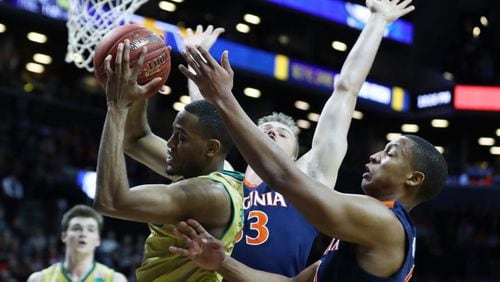After 13 games in five days, the 63rd ACC Tournament came to a riveting conclusion Saturday evening with Duke’s come-from-behind win over Notre Dame to secure its 20th conference championship, the most of any team in the league.
The talent and might of the ACC was on full display at the Barclays Center, with Duke, Notre Dame, North Carolina, Louisville, Florida State and Virginia all putting on performances on various days that gave indication that they have the capacity for deep runs in the NCAA tournament, although their limitations were sometimes evident, too.
It wouldn’t be a surpise if half of the Final Four were made up by two of the teams who fought one another in Brooklyn this past week. Four other observations after a week’s worth of games.
Tech’s shortcomings
Watching a series of games over the course of five days, some between some of the best teams in the country, provided a much clearer sense of how limited Georgia Tech has been this season in what it could do offensively. So often when Tech players have risen up for jump shots, they haven’t necessarily inspired a great deal of confidence that the ball would go in. Or, if the shot clock were running down, there hasn’t been a player who could find a way to create space for a jumper or slash to the basket for a makeable shot.
Tech’s opponents in the conference are not all loaded with stars, but have players that can consistently hit 3-pointers or slash to the basket and either make the shot or get fouled. It is not by accident that Tech is last in the league in field-goal percentage and in offensive efficiency (KenPom).
Having a player like Notre Dame guard Rex Pflueger, for instance, someone who is not a star but can handle the ball and can punish teams for leaving him open beyond the 3-point arc, likely would have made a significant difference during regular-season play.
Consider that Tech averaged .944 points per possession in league play, according to KenPom, far and away the least efficient team in the league. The No. 8 team, Notre Dame, averaged 1.096. The Jackets were 14 percent less efficient a scoring than the average ACC offense. That’s a lot of ground to cover and a lot of pressure to play with on the defensive end, where Tech was second in the ACC.
Looking like a Final Four team
Duke appeared to have put it together over its four-day run. Beating Louisville, North Carolina and Notre Dame on successive days (along with Clemson the previous day) is a remarkable feat, particularly considering the Blue Devils were in significant holes in the second half of each.
Freshmen Harry Giles and Jayson Tatum are finding their form and guard Luke Kennard had a way for hitting 3-pointers at the most opportune moments.
“We just put our hearts out there on the line, and that’s what everybody’s been doing, and it usually pays off,” guard Matt Jones said.
Interestingly, though, of the past six ACC champions, only one was able to parlay that into a Final Four trip – North Carolina last year. As you may recall, the Tar Heels came within an eyelash of winning the national title. But of the five before North Carolina, only one made it past the Sweet 16 – Notre Dame, which lost in the elite 8 in 2015. The last team to win both the ACC and NCAA titles in the same year was – you guessed it – Duke in 2010.
After the championship game, coach Mike Krzyzewski said he had concerns about a letdown because of the temptation to celebrate the accomplishment of the title and not keep looking ahead. Duke, though, has spring break coming up this week, which Krzyzewski said will give the team more rest time before the tournament starts.
Well received
The Brooklyn experiment looks like it was a success. Sellout or near-sellout crowds watched the final two rounds, although there were empty seats, particularly for late-night games. Fans surveyed about the experience highly enjoyed it and want to see it come back to the Barclays Center (which it will next year). Granted, it would stand to reason that people in the arena would be positive about the event. The ones who would pan Brooklyn as a tournament site watched the games from their homes in North Carolina.
Most fans surveyed by the AJC were from the New York area (including one couple, Duke fans, who moved to Long Island from Durham, N.C., on Friday). It’s unclear what percentage of fans at the tournament were from out of town. Clearly, New York is more expensive to get to from North Carolina and neighboring states than Washington or Charlotte or Atlanta. But, if local fans are attending the games in numbers similar to what they draw in Greensboro, N.C., or Charlotte, then that fulfills part of the motivation for moving the tournament around, to share the event with different fans inside the ACC footprint.
Challenge starts again
ACC coaches enjoy some good back patting. In post-game interviews this week, they remarked often on the difficulty and depth of the league. It’s perhaps understandable and not inaccurate. And any league that has a postseason like the ACC did last year, with six teams in the sweet 16 and two in the Final Four, is perhaps given some leeway on banner waving.
But now comes the part where the ACC will have to back it up again. The ACC could have as many as 10 members placed into the field – Wake Forest and Syracuse are on the bubble. Repeating the success of last year won’t be easily done, but the league should brace itself for criticism or mockery if it doesn’t.







